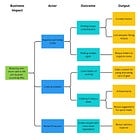Did You Just Make This Up?
Impact Maps and Assumptions
Let’s look again at the Impact Map example from the last post.
Of course, this example is pure fiction. But let’s assume an organization is creating a service like this. How much would you expect that the information captured here is backed up by deep research and thousands of data points?
Now, remember your last conversation about what is expected from your team or the product strategy. How much of the reasoning in the conversation was supported by authentic stories and actual data?
Impact Maps help you to have a more serious conversation about how much information you have and what you assume.
Let’s look at it level by level.
The baseline of the Business Impact is hopefully measured on actual data. The goal is obviously a target, not yet a fact.
The Actors are probably defined through research and your actual landscape. Maybe you even have quantified behavior segmentations and know your segments’ size and influence.
But it wouldn’t be the first time somebody created proto-personas based purely on best guess and ran with it.
The same is often valid for Outcomes. In some cases, deep research points to the exact moments the given Actor struggles. More often, we hear the same stories again and again from different user conversations and sources of user input, so this problem comes automatically up. Or sometimes we just get asked by the CEO to address a problem this buddy of his has.
Output represents ideas, so we know these are not validated until we start to create them.
Like in conversations, we express a lot of assumptions while mapping. But why are we even bothering to take the time to map these out? Because instead of just making a verbal statement, which might stay without any reflection. We see all the statements made in front of us and can argue about them.
To stay with the example, you could discuss in the group if the Curated Menus feature is really preventing Experienced Hobby Cooks from churning.
The goal is not to take apart every assumption, argue about it endlessly, or head off to research everything. The goal is to reflect as a group what all the assumptions are and, if everybody has the same understanding, of how much we already know about a given statement in the map.





